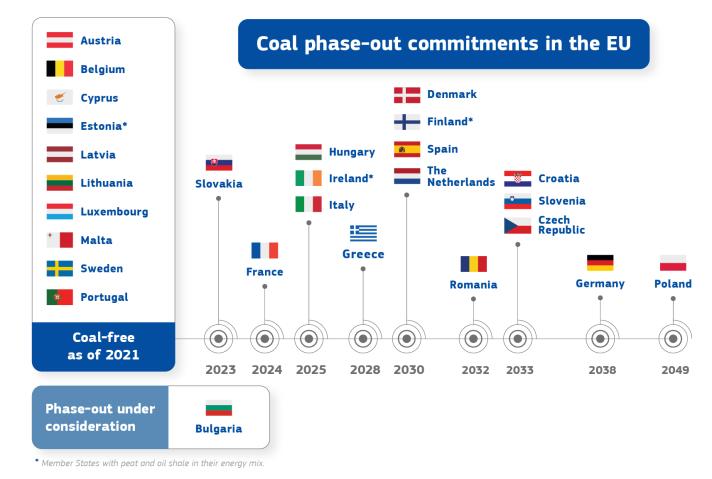
Coal Phase-Out
Coal power plants are in decline almost everywhere in the world outside of China, India, and other parts of Asia. Parts of Asia continue to grow their coal production, even while the US and Europe are reducing their coal consumption in line with the Paris Climate Accord and net zero targets.
The decline is very sharp in parts of Europe; with the United Kingdom currently using coal for only around 2% of the country’s electricity needs, and Germany with a coal phase-out date of 2030 all but set in stone.

Optimistically, Germany will aim for a 2030 coal phase-out date, with the caveat being that reliable sources of electricity must be in place to replace retiring coal plants for that to happen.
In Germany, coal has steadily been replaced with natural gas and renewables, but mostly with renewable energy these days.
The same story is true in the United States.
Perhaps surprisingly, coal is being steadily phased-down in the United States, as well. While the US decline in coal use is far from the UK’s rapid phase-out (the UK plans to phase-out coal completely by 2025), it’s still significant.

The decline in the US of 100 gigawatts (GW) last decade, from over 300 GW of coal capacity at the beginning of the decade (from 318 GW in 2011), down to 218 GW by 2020, can be attributed mainly to coal-to-gas switching (lower-priced, cleaner-burning natural gas taking the place of coal).
There is also a steady decline in this decade (from 218 GW in 2020 to 184 GW in 2023); with announced coal plant closures bringing the total GW of projected US coal power plant capacity down to 159 GW by 2026 and to 116 GW by 2030.
The new reason for the steady decline in coal-fired capacity in the United States this decade? Less expensive, and much cleaner, solar and wind energy, and battery storage for the new solar and wind energy capacity.
While Europe is leading the charge in terms of coal phase-outs, the US is making steady progress. If public and/ or private entities in the US were to buy out coal plants, just to have them retired, that would be helpful.
Without such intervention, or an official coal phase-out date for the country (which would have to pass the US Congress and be signed by the president, a highly unlikely scenario), the United States could see over 50 GW of coal power plants sticking around until 2040 or even beyond that.
However, it must be noted that the current decline in coal use in the US is significant and substantial. The US now gets under 18% of its electricity from coal, while getting over 22% of its electricity from renewable energy.
Meanwhile, coal phase-outs still aren’t happening fast enough globally –
“The world needs to phase out coal five times faster than it currently is to prevent “climate chaos”, according to a new report.
Around the world, more than 2,400 coal-fired plants are still up and running.
A new report by US NGO Global Energy Monitor says all of these must shut by 2040 and no new plants can open if countries want to meet their Paris Agreement climate goals.”
[Quote From – euronews.com/green/close-all-coal-plants-by-2040-to-prevent-climate-chaos-new-report-urges]
Coal Phase-Outs in Europe
Most European countries have ambitious coal phase-out targets (see chart below). The United Nations has advised that 2030 should be the phase-out date for coal-fired power plants in OECD countries to be on track to meet Paris climate targets.
Especially noteworthy, the United Kingdom’s coal consumption has gone down from providing about 40% of the country’s electricity needs in 2012 to just over 2% today. The UK plans to complete its coal phase-out by 2025, at which time there will be no coal plants operating in the country.
Among European nations; Belgium, Sweden, Portugal, and Austria have successfully completed coal phase-outs. Iceland and Switzerland haven’t had coal in their countries’ energy mix for several decades. Norway only has 1 coal mine left, which has a planned shut-down date of 2025.
Here is a chart with coal phase-out dates for countries within the European Union [Note – this chart was made prior to Germany’s on-again, off-again plans of a 2030 date for the phase-out of coal-fired power plants]:

Poland is an example of a heavily coal-reliant nation that does not have an ambitious phase-out date. About 70% of Poland’s electricity comes from coal-fired power plants, the most in the European Union.
Poland is not currently phasing down coal use at all, however, the country aims to close all coal mines in the country by 2049.
The phase-out of coal-fired power plants in Europe, as noted with coal-phase outs in the United States, began primarily with coal-to-gas switching, and has evolved towards renewable energy, especially wind and solar energy, as the primary driver of coal phase-outs.
Coal Phase-Outs in the United States
The United States has been the world’s 3rd largest producer and 3rd largest consumer of coal among the countries of the world, however, that is rapidly changing. Although there continues to be no hard date for the phase-out of coal-fired power plants for the US as a whole, coal has been steadily phased-down nonetheless throughout the country (and phased-out completely in certain US states).
The reason behind coal phase-downs in the US have been due to: 1. less expensive, cleaner alternatives, first in natural gas and, more recently, it has been predominantly wind and solar replacing coal, and 2. regulations on pollution from coal plants that make it nearly impossible for coal plants to operate profitably while also investing in cleaning up their operations.
The United States did join the Powering Past Coal Alliance in December of 2023, which means that the Biden administration is now committed to phasing out coal in the country, and not building any new coal plants in the US. However, there continues to be no official date for coal phase-out in the United States (the Biden administration has committed to making the US electrical grid carbon-free by 2035).
Hawaii has phased-out coal completely from the state’s energy mix. Hawaii gets an increasingly large share of energy from solar and wind, but also other renewables, such as biomass and geothermal energy. A few Northeastern US states have also phased out coal completely, while renewable energy has grown substantially, especially wind and solar.
Rhode Island and Vermont have no in-state coal-fired power plants. Washington plans to phase-out coal by 2025, and California (which still imports coal power from other states for just over 2% of its electricity) plans to phase-out coal by 2026.
Even states like Texas, Oklahoma, Kansas, and South Dakota are phasing-down coal and replacing coal with less expensive, cleaner wind and solar (and in some states, like South Dakota, it’s cheap and clean hydroelectricity primarily driving the green switch).
In the United States, 24 states have plans to retire coal plants, and there are no plans to build more coal capacity in any state. Wind energy has overtaken coal in states throughout the Great Plains sections of the US.
The timeline of natural gas during the previous decade primarily replacing coal due to being less expensive and cleaner, and now increasingly wind and solar replacing coal, holds true throughout much of the United States.
Coal Phase-Outs in Various Other Parts of the World
The following countries have set coal phase-out or phase-down dates (in addition to the European coal phase-out dates listed above):
Canada – Already, over half of Canada’s 10 provinces don’t use coal for electricity. All the way back in 2016, Canada announced plans to stop all unabated coal use for electricity by 2030 (unabated coal use is coal use without carbon capture).
Australia – Australia doesn’t have an official coal phase-out pledge, however, Australia aims to have 82% renewable energy country-wide for electricity by 2030 (up from a mix of just over 35% renewable energy and just under 50% coal currently). Australia is the 4th largest producer of coal, and the 2nd largest exporter of coal, in the world.
Japan – Japan also doesn’t have an official coal phase-out pledge, however, Japan aims to steadily phase-out “inefficient” coal use by 2030. Additionally, Japan plans to triple the country’s use of renewable energy, and increase its use of hydrogen and carbon capture. Japan is the 3rd largest importer of coal among world countries, but is just the 49th in coal production. Japan is the world’s 4th largest consumer of coal.
Indonesia – Indonesia has pledged to phase-out coal “in the 2040s” and also “by 2050” (in a couple of different public announcements by the country). However, even this long-range target might not be met by “captive” coal plants in the country (coal plants built inside of industrial parks that are dedicated to supplying power for the industrial park where the plant is located).
Like China and India, Indonesia continues to build new coal plants today, even while also adding renewable energy capacity, mostly in the form of solar and wind power. Indonesia is the 4th largest producer of coal in the world, and the world’s largest coal exporter.
Philippines – The Philippines ranked 6th in terms of new coal capacity in 2022. This is true despite the supposed “moratorium on new coal-fired power plants” that the Philippines has had since 2020. The Philippines is aiming to reach 35% renewable energy by 2030, which it plans to reach along with its growth in coal energy. The Philippines doesn’t have an official coal phase-out date.
South Korea – South Korea does not have plans to phase-out coal until the year 2040, at the soonest. South Korea has increased coal imports, and is now the 4th largest importer of coal globally, along with being the world’s 8th largest coal consumer. However, South Korea does not produce very much coal, and is only the world’s 44th coal producer.
Vietnam – Vietnam plans to phase-out coal in the 2040s. Vietnam is right behind South Korea, as the world’s 9th largest consumer of coal. Vietnam is the world’s 15th largest producer of coal, relying substantially on coal imports. Vietnam is the world’s 6th largest importer of coal.
Russia – Russia is the world’s 6th largest producer of coal, and also the 6th largest coal consumer. The fact that Russia has no coal phase-out date is even more significant considering that the country is #2 among world nations in proven coal reserves (behind the US). Russia is #3, behind Indonesia and Australia, for coal exports.
South Africa – South Africa relies on coal for around 70% of the country’s electricity. South Africa is the world’s 7th largest coal producer and the 5th largest coal exporter in the world. Despite being a part of a Just Energy Transition Partnership (JETP) with wealthy nations of the EU, the US, and the UK, which seek to phase-out coal and help finance South Africa’s coal phase-out (by 2035), there is significant pushback from the country’s coal interests. South Africa will build renewable energy capacity, and at the same time continue to develop its coal industry.
India, Indonesia, and Vietnam are other countries with JETP deals. Countries with JETPs can transition from fossil fuels to clean energy much quicker with all of the assistance they can potentially receive.
JETPs now not only include countries of the EU, the US, and the UK, but also include multilateral development banks, national development banks, and development finance agencies. Developing nations in JETPs can get financial assistance, such as grants and loans, for the nation’s clean energy transition.
Here is a world map of coal phase-out dates, from ourworldindata.org/coal-phase-out-timeline:
Coal Use in China and India
Just the two countries China and India represent almost 70% of the world’s demand for coal. China and India together consume about double the amount of coal as the rest of the world combined. China and India are the world’s #1 and #2 producers of coal and the #1 and #2 importers of coal, respectively.
China alone uses half of the world’s coal supply. Both China and India are increasing the amount of coal they use, and continue to build new coal-fired power plants.
However, both China and India are also rapidly deploying and implementing renewable energy, especially wind and solar. As developing nations, China and India are increasing production and consumption of energy of all kinds to advance the standard of living for their populations, and to make progress in various economic and social sectors.
The rise in clean energy production in China is projected to drive coal consumption to peak in 2025. On the other hand, even with the rise of renewables in the country, India will continue to ramp up its coal production this decade.
